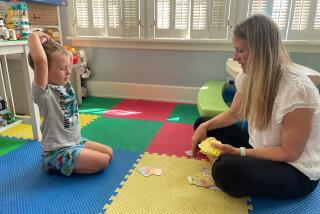Battle Fatigue
See Dad yell.
See Mom yell back.
See Mom and Dad yell louder.
See Dick and Jane wish they were somewhere else.
Conflict is part of marriage. Contentiousness is part of being a family. Friction is built into the mix. Still, when parents chronically fight, kids suffer. Itâs as true for Bart Simpson as it was for the Beaver. Mom and Dad steam; kids feel the heat. If the burners are turned on long enough, kids can get scalded. And, psychologists now know, it just keeps getting worse.
âThere was a general hypothesis that kids who are exposed to a high level of conflict get desensitized,â said Dr. Gayla Margolin of USC, âbut the majority of studies coming out now say they actually become more sensitized. Theyâre in a state of psychological arousal, so theyâre more reactive. Small things might bother them more. They might become overly sensitive to conflict with their peers.â
Margolin, a professor of psychology and director of clinical training who has co-authored several studies on marital conflict and its effects on parents and children, said that children who are exposed to a relentless climate of conflict within their homes may suffer emotionally not only in childhood, but may grow up to become emotionally distant adults. And the fighting need not become physical to inflict the damage.
âThe effects of growing up with emotional conflict can be very similar to those in a physically violent home,â Margolin said. âEmotional abuse or constant conflict or denigration can be as negative as physical violence. Among kids who grow up and are still suffering from it, the real turning point is when as young adults they get involved in their own relationships. If they have seen only a lot of negative attractions, they may not have any kind of model of a relationship that can succeed.â
The short-term effects can be troubling enough, as some of Margolinâs studies show. In one study, 74 children, ages 9 to 13, listened to audiotapes of actors simulating different types of marital conflict, such as name-calling, negative verbal arguments, threats to leave the marriage and even physical aggression. A direct correlation was found between the childrenâs negative emotions in response to the tape and the level of conflict the situations portrayed.
On the other hand, when tapes were played in which actors simulated a conflict that was resolved peacefully and well, all of the children reacted positively.
Children cope with conflict in a two main ways, the study showed. Boys from so-called high-conflict homes were more likely to personally intervene in the fight, verbally and occasionally physically. Margolin speculated that this is likely a response to the boysâ recognition of their own growing size and strength, as well as their desire to protect their mothers.
Girls from high-conflict homes, however, were more inclined to choose what the study called âchild-directed solutionsâ--trying to come up with an idea themselves that would defuse the conflict.
More universal responses among children included seeking out others such as a friend or relative, protecting themselves by leaving the house or expressing their emotion by going to their room and crying.
âKids donât ignore the conflict, even if they look like theyâre ignoring it,â said Dr. Andrew Christiansen, a professor of psychology at UCLA. âThe parents are the two most important people in their lives.â
When the child becomes the focal point of the argument, said Christiansen, the stress increases still more.
âItâs one thing for the parents to argue about money,â he said, âbut itâs another thing for them to be in conflict over the child. The kid gets pulled into it and pulled between the parents.â
A review article titled âThe Effects of Domestic Violence on Children,â a synthesis of many studies, found that when arguments between parents escalate into chronic violence, children âexhibit a high level of stress-related disorders, including health problems, externalizing or acting-out problems, problems with the law, school problems, and a wide range of internalizing disorders, reflecting low self-concept, fear and anxiety and social isolation.â Later, the study said, children exposed to physical violence may become enmeshed in violence in their dating and marriage relationships, both as victims and aggressors.
*
But this is not inevitable, Margolin said.
âThere used to be people who would say there was an automatic translation: If you grew up that way, youâd behave that way as an adult,â she said. âBut the majority say, âI donât want that and I donât want that for my kids.â They make a conscious decision that they absolutely will not tolerate that.â
Also, she said, children may see conflict but also may experience great love as well--from a supportive adult, a teacher, a grandparent, other loving families or even from one or both of the battling parents. And this may help shepherd the child into an emotionally stable adulthood.
It is possible to break the cycle of conflict, said Margolin and Christiansen.
âA large part of marital therapy entails teaching communications skills,â Margolin said. âA big step is a coupleâs attitudes toward each other and the argument. If they go into the argument with the attitude that they want to make their point or win the argument, whatever the cost, the more vicious the argument may be. On the other hand, people can be diametrically opposed and still look for ways that they can live with those disagreements.â
Some rules for disagreeing are to avoid âany kind of derogatory name-calling, labeling the other person in terms of personality traits, and using global statements like âalwaysâ and ânever.â The most basic skill is getting people to listen to each other rather than cutting the other off before the words are even out.â
One of Margolinâs studies characterized couples as âdistressedâ and ânon-distressed.â It repeated a finding that held that the non-distressed couples exhibited a âbank accountâ theory of behavior exchange. That is, non-distressed couples deposit and withdraw behaviors, being able to write checks (behave negatively) as long as the total account does not become overdrawn. In fact, they may have âoverdraftâ protection, based on past credit (relationship) history.
Distressed couples, however, âare more sensitive to immediate events than are low-conflict couples. In other words, the bank account for these couples may be close to zero, and they are frequently found to have ânonsufficient funds.â â
At this, the Homer Simpson family likely is preferable to the Flanders bunch next door. The Flanders kids live in a doggedly conflict-free home, blissed-out and nontoxic, but are nonetheless bundles of anxieties. Homer and Marge Simpson fight, make up and move on and manage--albeit oddly--to maintain a loving family.
âItâs not necessarily a good idea, even if you could, to keep all conflict from your children,â Christiansen said. âYou donât necessarily want to hold up a model of parents who never get angry at each other. Ideally, the model is getting angry, disagreeing, but handling it in constructive ways--expressing anger rather than belittling or humiliating the other person.
âIt may be better for kids to see that their parents are human beings.â






